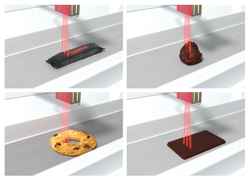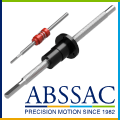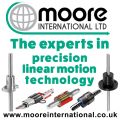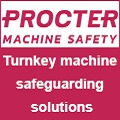
Posted to News on 14th Sep 2020, 11:38
Advances in reference diffuse sensor technology
Sensing technology continues to move at pace. Here, Dr Marie-Theres Heine of Leuze electronic updates machine builders on a new operating principle, highlighting the company's DRT 25C dynamic reference diffuse sensor with CAT technology.

With the DRT 25C dynamic reference diffuse sensor, Leuze has brought a new operating principle to the field of switching sensors. At the heart of the new product is CAT technology, which transforms a simple diffuse sensor into a highly intelligent device. This can be seen in the DRT 25C's novel mode of operation: it is taught in on a reference surface at the press of a button, from which point it can then reliably detect nearly all objects, irrespective of their shape, colour or surface structure. Serving as the reference surface is anything available in the given application environment: for example, a machine wall, a piece of sheet metal, or even a vibrating and moving conveyor belt. This makes the sensor particularly well suited for packaging system machinery, and especially so in the area of confectionery and baked goods. Of interest to users is that n readjustment is necessary when changing objects.
Some history
Leuze developed its first optical sensor almost 60 years ago and numerous technological milestones and innovations have followed since. In just the last 10 years the company has registered more than 200 patents. Our staff have in-depth application know-how in a variety of demanding industries including packaging where throughputs of several hundred thousand products per day are commonplace and where finely tuned, high-speed processes place high demands on optical sensors. Clear-glass retro-reflective photoelectric sensors require less maintenance through smart tracking and thanks to line-shaped light spots, laser diffuse sensors detect objects - no matter how complex they are - on their front edge. Extremely powerful through-beam photoelectric sensors can detect a chocolate bar in its outer packaging with completely harmless infrared light. The intelligent CAT technology embraced by Leuze and which the new DRT 25C dynamic reference diffuse sensor uses, continues the idea of the "clever' sensor.
Detection on a running conveyor belt
Packaging and the objects to be packaged obviously vary widely in colour, shape and surface structure from the flat to the glossy, those with openings or those which are transparent - a real variety right across the entire spectrum. Some of these are not so easy to detect, and overcoming this is the real task of optical sensors in packaging systems. The fundamental challenge in object detection is in detecting it as quickly and reliably as possible, and ideally directly from above. At the same time, the working environment poses a challenge too: the objects to be detected are usually on conveyor belts that move and vibrate and which may also become soiled or wet. The sensors currently on the market have so far only been able to perform this task to what we believe is a limited extent, hence our developing products precisely for such an intelligent model.
CAT technology: Contrast Adaptive Teach
This market requirement led to the development of the CAT technology here at Leuze. CAT stands for Contrast Adaptive Teach. The underlying idea is simple: if the object can change at any time, use its environment instead as a constant reference surface. In packaging systems, this is the conveyor belt, which serves as a teachable reference. Once the sensor has been taught the contrast information of the conveyor belt, it only needs to be intelligent enough to adapt this knowledge to a possible change of environment, and this is precisely what CAT technology does.
Operating principle of dynamic reference diffuse sensors
The new Leuze DRT 25C dynamic reference diffuse sensor uses this CAT technology in a new operating principle: it learns the signal parameters of the conveyor belt at the press of a button and stores them as the "standard zero". Every object that is transported on the conveyor belt now generates a signal, and if this deviates from the "zero" state, the DRT 25C will reliably detect the object as a "deviation from the referenc". The performance of the device is optimised through a choice of teach levels. There is, for example, a specific teach routine for conveyor belts that are likely to become heavily soiled over time. Another teach level exists especially for the detection of very flat (or even transparent) objects. Once the sensor has been "taught", no additional settings or readjustments are necessary, not even if the object is changed, as the sensor operates together with the conveyor belt as a reference.
Reliable detection increases throughput
If, for example, a chocolate bar is not reliably detected, a mishap may quickly occur in the subsequent, precisely cycled packaging, which must then be removed and cleaned. The more reliably the sensor detects the product, the less frequent is the unplanned maintenance that may need to be performed. Herein lies what we believe is a key strength of the DRT 25C dynamic reference diffuse sensor: it operates reliably even with difficult shapes and surfaces. This increases machine throughput and production quantity and also avoids unnecessary downtime. Because no adjustment work needs to be performed on the sensor when changing products or changing the packaging materials, setup time is also reduced, further increasing output quantities. Up until now, a format change - such as from a classic 100 g bar of chocolate to a mini chocolate cube - meant that the sensors had to be readjusted. But because the DRT 25C uses the conveyor belt as a reference, this is no longer necessary. Even if the colour, height or contour of the packaging changes, no settings need to be made at all on the dynamic reference diffuse sensor.
The DRT25C dynamic reference diffuse sensor represents a new operating principle that is based on our new intelligent CAT technology. We think it sets new technological standards and it is certainly another important milestone in the innovation history of Leuze. Reduced downtimes, increased machine throughput as well as higher production quantities, all with maximum flexibility without readjustment when changing objects - that means increased cost effectiveness for our customers.
Go to www.leuze.co.uk for more information about the DRT 25C dynamic reference diffuse sensor.
1B Fenice Court
Phoenix Park
Eaton Socon
PE19 8EW
UNITED KINGDOM
+44 (0)1480 408500

































